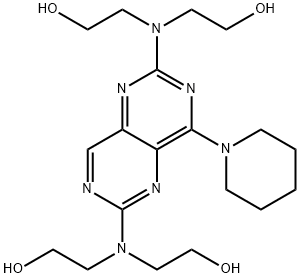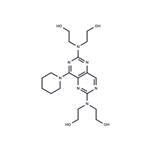Originator
Rapenton,Thomae,W. Germany,1980
Manufacturing Process
3.9 g (0.06 mol) of zinc powder were introduced into a solution of 5.0 g (0.01
mol) of 2,6-bis-(diethanolamino)-4,8-dipiperidino-pyrimido-[5,4-d]-pyrimidine
(dipyridamole; see entry under that name for its synthesis) in 120 cc of
aqueous 10% formic acid. The resulting mixture was heated on a water bath,
while occasionally stirring, until the intense yellow color of the starting
compound disappeared, which occurred after about 30 to 40 minutes.
Thereafter, the unconsumed zinc powder was separated by vacuum filtration,
the virtually colorless filtrate was essentially an aqueous solution of 2,6-bis-
(diethanolamino)-8-piperidino-1,2,3,4-tetrahydropyrimido-[5,4-d]pyrimidine.
The filtrate was adjusted to a pH of 9 by adding concentrated ammonia, and
then a 1 N aqueous iodine-potassium iodide solution was added dropwise,
whereby the tetrahydropyrimido[5,4-d]pyrimidine obtained by hydrogenation
with zinc in formic acid was converted by oxidation into 2,6-bis-
(diethanolamino)-8-piperidino-pyrimido-[5,4-d]-pyrimidine. The completion of
the oxidation was checked by means of a starch solution. The major amount
of the oxidation product already separated out as a deep yellow crystalline
precipitate during the addition of the iodine solution. After the oxidation
reaction was complete, the reaction mixture was allowed to stand for a short
period of time, and then the precipitate was separated by vacuum filtration,washed with water and dried. It had a melting point of 157°C to 158°C. The
yield was 8.0 g, which corresponds to 95% theory.

